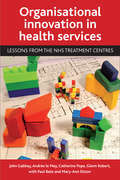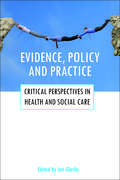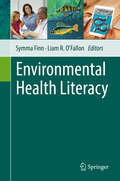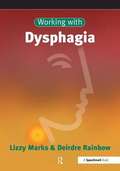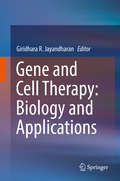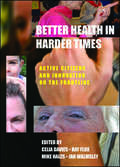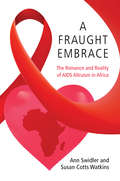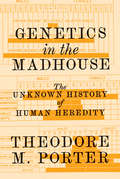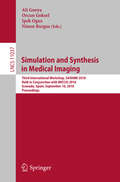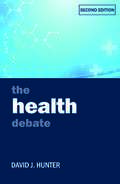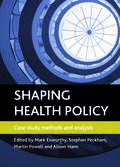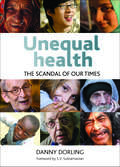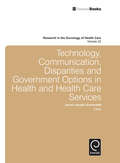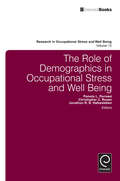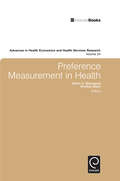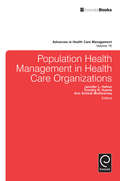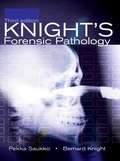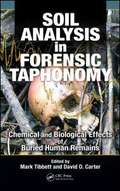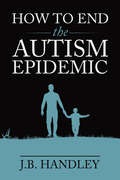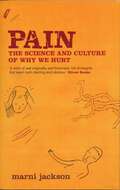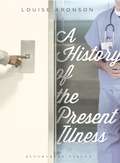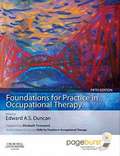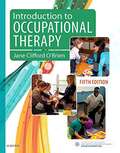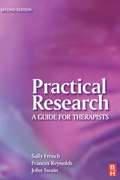- Table View
- List View
Organisational innovation in health services: Lessons from the NHS Treatment Centres
by John Gabbay Andrée Le MayAmid a welter of simultaneous policy initiatives, treatment centres were a top-down NHS innovation that became subverted into a multiplicity of solutions to different local problems. This highly readable account of how and why they evolved with completely unforeseen results reveals clear, practical lessons based on case study research involving over 200 interviews. Policy makers, managers and clinicians undertaking any organisational innovation cannot afford to ignore these findings.
Evidence, policy and practice: Critical perspectives in health and social care
by Jon GlasbyThis edited book provides a hard-hitting and deliberately provocative overview of the relationship between evidence, policy and practice, how policy is implemented and how research can and should influence the policy process. It critiques the notion of 'evidence-based practice', suggesting instead a more inclusive idea of 'knowledge-base practice', based in part on the lived experience of service users. It will be of interest to everyone in health and social care policy, practice and research.
Environmental Health Literacy
by Symma Finn Liam R. O'FallonThis book explores various and distinct aspects of environmental health literacy (EHL) from the perspective of investigators working in this emerging field and their community partners in research. Chapters aim to distinguish EHL from health literacy and environmental health education in order to classify it as a unique field with its own purposes and outcomes. Contributions in this book represent the key aspects of communication, dissemination and implementation, and social scientific research related to environmental health sciences and the range of expertise and interest in EHL. Readers will learn about the conceptual framework and underlying philosophical tenets of EHL, and its relation to health literacy and communications research. Special attention is given to topics like dissemination and implementation of culturally relevant environmental risk messaging, and promotion of EHL through visual technologies. Authoritative entries by experts also focus on important approaches to advancing EHL through community-engaged research and by engaging teachers and students at an early age through developing innovative STEM curriculum. The significance of theater is highlighted by describing the use of an interactive theater experience as an approach that enables community residents to express themselves in non-verbal ways.
Working With Dysphagia (Working With Series )
by Lizzy Marks Deirdre RainbowThis practical text is indispensable to all clinicians working with dysphagia and is suitable for those involved in a range of settings and with a diversity of client groups. With its perspective on everyday working practice, "Working with Dysphagia" fills a gap in an area where practical and workable material is much sought after. This book is a useful resource for all therapists, ranging from students to specialist, as the practical assessment approach and comprehensive management strategies are supported throughout with references of recent relevant research.
Working With Dysphagia (Working With Series )
by Lizzy Marks Deirdre RainbowThis practical text is indispensable to all clinicians working with dysphagia and is suitable for those involved in a range of settings and with a diversity of client groups. With its perspective on everyday working practice, "Working with Dysphagia" fills a gap in an area where practical and workable material is much sought after. This book is a useful resource for all therapists, ranging from students to specialist, as the practical assessment approach and comprehensive management strategies are supported throughout with references of recent relevant research.
Gene and Cell Therapy: Biology and Applications
by Giridhara R. JayandharanRecent advances in stem cell biology, nanotechnology and gene therapy have opened new avenues for therapeutics. The availability of molecular therapeutics that rely on the delivery of DNA, RNA or proteins, harnessing enhanced delivery with nanoparticles, and the regenerative potential of stem cells (adult, embryonic or induced pluripotent stem cells) has had a tremendous impact on translational medicine. The chapters in this book cover a range of strategies for molecular and cellular therapies for human disease, their advantages, and central challenges to their widespread application. Potential solutions to these issues are also discussed in detail. Further, the book addresses numerous advances in the field of molecular therapeutics that will be of interest to the general scientific community. Lastly, the book provides specific examples of disease conditions for which these strategies have been transferred to the clinic. As such, it will be extremely useful for all students, researchers and clinicians working in the field of translational medicine and molecular therapeutics.
Better health in harder times: Active citizens and innovation on the frontline (PDF)
by Celia Davies Jan WalmsleyFor years the NHS has been the most trusted of public institutions and the envy of many around the world. But today there is turmoil. Painful shortcomings in clinical care and patient experience, together with funding cuts, threaten to dig deep into service levels and standards. Seventy years of technically advanced medicine provided free to the population has produced a widespread perception of patients as passive consumers of health care. This book explores how we may renew for our times the collective compact that created our public services in the 1940s. Voices from service users and service providers show how this can be done. They offer testimony of what goes wrong and what can be put right when working together becomes the norm. Sections explore new ways of living and working with long-term conditions, more meaningful and effective approaches to service redesign, use of information technology, leadership, co-production and creating and accounting for quality. Accessible to a wide range of readers, with short, accessible contributions, this is a book to provoke and inspire.
A Fraught Embrace: The Romance and Reality of AIDS Altruism in Africa (Princeton Studies in Cultural Sociology #72)
by Ann Swidler Susan Cotts WatkinsThe complex relationships between altruists, beneficiaries, and brokers in the global effort to fight AIDS in AfricaIn the wake of the AIDS pandemic, legions of organizations and compassionate individuals descended on Africa from faraway places to offer their help and save lives. A Fraught Embrace shows how the dreams of these altruists became entangled with complex institutional and human relationships. Ann Swidler and Susan Cotts Watkins vividly describe the often mismatched expectations and fantasies of those who seek to help, of the villagers who desperately seek help, and of the brokers on whom both Western altruists and impoverished villagers must rely.Based on years of fieldwork in the heavily AIDS-affected country of Malawi, this powerful book digs into the sprawling AIDS enterprise and unravels the paradoxes of AIDS policy and practice. All who want to do good—from idealistic volunteers to world-weary development professionals—depend on brokers as guides, fixers, and cultural translators. These irreplaceable but frequently unseen local middlemen are the human connection between altruists' dreams and the realities of global philanthropy.The mutual misunderstandings among donors, brokers, and villagers—each with their own desires and moral imaginations—create all the drama of a romance: longing, exhilaration, disappointment, heartache, and sometimes an enduring connection. Personal stories, public scandals, and intersecting, sometimes clashing fantasies bring the lofty intentions of AIDS altruism firmly down to earth.Swidler and Watkins ultimately argue that altruists could accomplish more good, not by seeking to transform African lives but by helping Africans achieve their own goals. A Fraught Embrace unveils the tangled relations of those involved in the collective struggle to contain an epidemic.
Genetics in the Madhouse: The Unknown History of Human Heredity
by Theodore PorterThe untold story of how hereditary data in mental hospitals gave rise to the science of human heredityIn the early 1800s, a century before there was any concept of the gene, physicians in insane asylums began to record causes of madness in their admission books. Almost from the beginning, they pointed to heredity as the most important of these causes. As doctors and state officials steadily lost faith in the capacity of asylum care to stem the terrible increase of insanity, they began emphasizing the need to curb the reproduction of the insane. They became obsessed with identifying weak or tainted families and anticipating the outcomes of their marriages. Genetics in the Madhouse is the untold story of how the collection and sorting of hereditary data in mental hospitals, schools for "feebleminded" children, and prisons gave rise to a new science of human heredity.In this compelling book, Theodore Porter draws on untapped archival evidence from across Europe and North America to bring to light the hidden history behind modern genetics. He looks at the institutional use of pedigree charts, censuses of mental illness, medical-social surveys, and other data techniques--innovative quantitative practices that were worked out in the madhouse long before the manipulation of DNA became possible in the lab. Porter argues that asylum doctors developed many of the ideologies and methods of what would come to be known as eugenics, and deepens our appreciation of the moral issues at stake in data work conducted on the border of subjectivity and science.A bold rethinking of asylum work, Genetics in the Madhouse shows how heredity was a human science as well as a medical and biological one.
Simulation and Synthesis in Medical Imaging: First International Workshop, Sashimi 2016, Held In Conjunction With Miccai 2016, Athens, Greece, October 21, 2016, Proceedings (Lecture Notes in Computer Science #9968)
by Ali Gooya Orcun Goksel Ipek Oguz Ninon BurgosThe health debate 2nd edition (Policy and Politics in the Twenty-First Century (PDF))
by David J. HunterHealth care systems everywhere face multiple pressures from changing demography, the rise of non-communicable disease, the growing demand on health services, and limited resources at a time of austerity. Focusing on the British NHS from a political science perspective, this second edition of this best-selling book offers a fresh look at how it is coping with such pressures. The book explores the complexity of health policy and health services, offering a critical perspective on concerns including integrated care, the return of public health to local government and moves to devolve health services to local level. Crucially, it offers a critique of the market-style changes introduced by the Coalition government between 2010 and 2015. Students of health care and health policy, policy-makers and public health and health care professionals will find this lively and accessible reassessment of NHS reforms invaluable.
Shaping health policy: Case study methods and analysis (PDF)
by Mark Exworthy Stephen PeckhamThis collection examines the role that case-studies play in understanding and explaining British health policy. Overall, the chapters cover the key health policy literatures in terms of the policy process, analytical frameworks and some of the seminal moments of the NHS. They have been written by leading health policy researchers in sociology, social policy, management and organisation studies. The collection explores and promotes the case-study as an under-used method and thereby encourages a more reflective approach to policy learning by practitioners and academics. The book will appeal to under-graduates, post-graduates and academics in social policy, public management and health services research.
Unequal health: The scandal of our times (PDF)
by Danny DorlingHealth inequalities are the most important inequalities of all. In the US and the UK these inequalities have now reached an extent not seen for over a century. Most people's health is much better now than then, but the gaps in life expectancy between regions, between cities, and between neighbourhoods within cities now surpass the worst measures over the last hundred years. In almost all other affluent countries, inequalities in health are lower and people live longer. In his new book, academic and writer Danny Dorling describes the current extent of inequalities in health as the scandal of our times. He provides nine new chapters and updates a wide selection of his highly influential writings on health, including international-peer reviewed studies, annotated lectures, newspaper articles, and interview transcripts, to create an accessible collection that is both contemporary and authoritative. As a whole the book shows conclusively that inequalities in health are the scandal of our times in the most unequal of rich nations and calls for immediate action to reduce these inequalities in the near future.
Technology, Communication, Disparities and Government Options in Health and Health Care Services (Research in the Sociology of Health Care #32)
by Professor Jennie Jacobs KronenfeldThis volume includes papers related to issues of technology, communication, health disparities and government options in health and health care services. It fills an existing gap by providing a clear sociological overview and focus on these topics. Technology is considered from the perspectives of providing healthcare equity, health disparities and the impact on doctor-patient relationships. The topic of communication is addressed in the format of public health messages and the use of internet chat rooms for discussions about health care services. Government roles and responsibilities are reflected upon in terms of health promotion, marketing and sales of health-related products and improving long-term care programs. Particular mention is made to learning lessons from the experiences and perspectives of other countries. Finally, health disparities are considered in socioeconomic terms, with particular reference to aging, depression, measures of health and healthcare in rural locations.
The Role of Demographics in Occupational Stress and Well Being (Research in Occupational Stress and Well-being #12)
by Pamela L. Perrewe Christopher C. Rosen Jonathon R. HalbeslebenThis peer-reviewed series promotes theory and research in the expanding area of occupational stress, health and well-being. Each volume of this series focuses on a particular topic, allowing authors and readers in that area to critically explore the cutting edge work from their discipline. Interest in organizational demography spans several decades (e.g., Pfeffer, 1983). However, in much of the contemporary research on occupational stress and well-being, demographic factors such as gender, age, and race/ethnicity are evident in the background and controlled in statistical analysis. In this volume, we ask whether that should be the case and the extent to which those demographics impact our experience of stress and well-being. Topics for this volume include age, occupational strain, and well-being using a person-environment fit perspective; race, stress, and well being in organizations; gender facades, biological sex, and gender role stereotypes in the workplace; age, resilience, wellbeing, and positive work outcomes; conceptual/theoretical issues related to religion and stress/well-being; and sex and sexual orientation on occupational stress and well being.
Preference Measurement in Health (Advances in Health Economics & Health Services Research #24)
by Glenn C. Blomquist Kristian BolinMeasurements of individual benefits of different health and medical interventions are fundamental for prioritizing among different alternative uses of resources in the healthcare sector. While psychometric measures do not necessarily provide information sufficient for assigning relative values to different health states, preference-based approaches produce measures that allow comparisons of such values. In this volume of the series of Advances in Health Economics and Health Services Research, entitled Preference Measurement in Health, the papers cover altruism within families, differences in risk attitudes, and estimation of health benefits of food safety. Specific topics include efficiency and altruism, comparison of mother and daughter values of HPV vaccination for daughters, differences in risk attitudes between women and men, how context matters in valuing food safety programs, and valuation of health risks associated with pesticide use.
Population Health Management in Health Care Organizations (Advances in Health Care Management #16)
by Timothy R. Huerta Jennifer L. Hefner Ann Scheck McAlearneyThe mission of healthcare organizations has undergone a remarkable transformation from curing disease to caring for the well-being of populations. While health care policy has explored this domain before, notably in Health Maintenance Organizations, the current efforts to create Patient-Centered Medical Homes (PCMHs) and Accountable Care Organizations (ACOs) represent a broader effort to move organizational responsibilities towards population health and care management. Volume 16 of AHCM presents papers that explore this topic across various levels of the healthcare system and employing multiple research designs including case studies, theoretical pieces, secondary data analyses, survey research and qualitative methodologies. Aspects of health care organization discussed in this volume include the PCMH, ACOs, integration with the public health and mental health systems, hospital-physician alignment, and resource planning. Population health management is presented as a factor driving these organizational changes and as a mechanism to facilitate this change.
Knight's Forensic Pathology (PDF)
by Bernard Knight Pekka SaukkoIn this third edition, Knight's Forensic Pathology continues to be the definitive international postgraduate textbook for forensic pathologists, covering all aspects of the medico-legal autopsy, including the cause and time of death, interpretation of wounds and every other facet of the investigation of a fatality. The emphasis is on the practical application of knowledge and research findings, and the new edition continues the often praised traditions of clarity and succinct presentation. This book will be an essential text for all pathologists in training, and remains a standard text to those in practice.
Soil Analysis In Forensic Taphonomy: Chemical And Biological Effects Of Buried Human Remains (PDF)
by Mark Tibbett David O. CarterA burial environment is a complex and dynamic system. It plays host to an abundance of interdependent chemical, physical, and biological processes, which are greatly influenced by the inclusion of a body and its subsequent decay. However, while taphonomy continues to emerge as a valuable forensic tool, until now most of the attention has been on the cadaver rather than the grave itself. Soil Analysis in Forensic Taphonomy: Chemical and Biological Effects of Buried Human Remains is the first book to concentrate entirely on the telling impact of soil and its components on the postmortem fate of human remains. Examining the basic physicochemical composition of the soil as it relates to forensic science and taphonomy, leading experts from across the world― · Offer an introduction to the nature, distribution, and origin of soil materials in forensic comparisons · Discuss the action of biological soil components, including invertebrates, fungi, and bacteria · Address rates and processes of decomposition and time of death estimates · Detail methods for characterizing and fingerprinting soils · Provide extensive information on the decomposition of hair Edited by Mark Tibbett, a soil microbiologist and David Carter, a forensic scientist, this unique resourceprovides an up-to-date overview of fundamental scientific principles and methods used in forensic taphonomy from a soils-based perspective. It provides an understanding of the processes at work, as well as practical methods and advice for those involved with active investigation.
How to End the Autism Epidemic: Revealing The Truth About Vaccines
by J. B. HandleyIn How to End the Autism Epidemic, Generation Rescue’s co-founder J.B. Handley offers a compelling, science-based explanation of what’s causing the autism epidemic, the lies that enable its perpetuation, and the steps we must take as parents and as a society in order to end it. While many parents have heard the rhetoric that vaccines are safe and effective and that the science is settled about the relationship between vaccines and autism, few realize that in the 1960s, American children received three vaccines compared to the thirty-eight they receive today. Or that when parents are told that the odds of an adverse reaction are “one in a million,” the odds are actually one in fifty. Or that in the 1980s, the rate of autism was one in ten thousand children. Today it’s one in thirty-six. Parents, educators, and social service professionals around the country are sounding an alarm that we are in the midst of a devastating public health crisis—one that corresponds in lockstep with an ever-growing vaccine schedule. Why do our public health officials refuse to investigate this properly—or even acknowledge it? In How to End the Autism Epidemic, Handley confronts and dismantles the most common lies about vaccines and autism. He then lays out, in detail, what the truth actually is: new published science links the aluminium adjuvant used in vaccines to immune activation events in the brains of infants, triggering autism; and there is a clear legal basis for the statement that vaccines cause autism, including previously undisclosed depositions of prominent autism scientists under oath. While Handley’s argument is unsparing, his position is ultimately moderate and constructive: we must continue to investigate the safety of vaccines, we must adopt a position of informed consent, and every individual vaccine must be considered on its own merits. This issue is far from settled. By refusing to engage with parents and other stakeholders in a meaningful way, our public health officials destroy the public trust and enable the suffering of countless children and families.
Pain: The Fifth Vital Sign
by Marni JacksonWhy is pain so poorly understood? Why do we still distinguish between mental pain and physical pain, when pain is always an emotional experience? How can it be that science is about to clone a human being but still can't cure the pain of a bad back? If pain is the reason why most people visit the doctor, why are most doctors so bad at addressing the problem of suffering? Marni Jackson's PAIN: THE FIFTH VITAL SIGN is a witty, personal and groundbreaking inquiry into the nature, treatment and definition of human pain, one of the most misunderstood and elusive subjects to challenge humankind. In the questing and narrative manner of Oliver Sacks, Jackson takes us back into the history of pain and forward into the possibilities of pain genetics, Jackson brings us stories both of people in pain and the pain pioneers: eccentrics and artists, wrestlers and writers, psychologists and philosophers, nurses and doctors. Above all, Pain makes an elusive subject vivid and readable. We all know what pain is. Now Marni Jackson has given it a voice.
A History of the Present Illness: Stories
by Louise AronsonA busy doctor juggles an errant teenage daughter and a seriously ill father. An elderly immigrant sacrifices his demented wife's well-being to satisfy his son's authority. A trainee becomes delirious with lack of sleep but must learn how to act, and not react, in the face of suffering. A psychiatrist who advocates for the underserved may herself be crazy. Together these deeply humane linked stories - at once funny and honest, incisive and compassionate - explore the impact of illness on real people's lives and offer a portrait of health and medicine like nothing we have read before. Set in hospitals, offices, nursing homes, prisons, family apartments and out and about in the city, A History of the Present Illness creates a world pulsating with life and introduces a striking new literary voice.
Foundations For Practice In Occupational Therapy (PDF)
by Edward A. S. DuncanNow in its fifth edition, the internationally acclaimed Foundations for Practice in Occupational Therapy continues to provide a practical reference tool which is both an indispensable guide to undergraduates and a practical reference tool for clinicians in the application of models and theories to practice. Underlining the importance and clinical relevance of theory to practice, the text provides an excellent introduction to the theoretical basis of occupational therapy. Contributions are given by both academics and expert clinicians. All chapters have been revised and updated, new ones have been written and some pre-existing chapters have new authors. A refined structure uses highlight boxes to indicate the key themes and issues of each chapter and useful reflective questions to help the reader review the issues raised in the chapter.
Introduction To Occupational Therapy (PDF)
by Jane Clifford O'BrienPrepare for success in OT practice with a complete overview of the profession! Introduction to Occupational Therapy, 5th Edition helps you master the roles and responsibilities of the OT practitioner. Content promotes evidence-based OT practice, from client evaluation to planning interventions and goals to reaching optimal outcomes. You'll also learn valuable skills in clinical reasoning and in providing occupational therapy across the client's entire lifespan. Written by experienced educator and author Jane Clifford O'Brien, this comprehensive resource discusses today's OT treatment settings and adds a new chapter on cultural competence. Complete coverage of OT practice prepares you for care in areas such as adult, pediatric, geriatric, and mental health. A broad perspective fits the needs of both Occupational Therapy and Occupational Therapy Assistant students. Case studies and activities in each chapter help you apply concepts and develop problem-solving skills. Emphasis on evidence-based practice helps you learn to think logically and use research literature to formulate diagnoses and treatment plans. The OT Practice Framework provides a sound basis for decision making, defining occupational therapy areas of concern and the OT process. Chapter objectives, key terms, chapter summaries, and review questions highlight important content in each chapter. Student resources on the Evolve companion website include review questions with answers along with crossword puzzles to reinforce what you've learned in the book. NEW content on OT theory and practice includes the latest updates to the Occupational Therapy Practice Framework and OT Code of Ethics. New coverage of the role of certified Occupational Therapy Assistants shows where OTAs are employed, what licensure requirements they must meet, and how they fit into the scope of OT practice. NEW chapter on cultural competence provides the tools you need to work with culturally diverse clients in today's healthcare environment, and includes case studies with examples of cultural competence and its impact on the practice of OT. NEW Centennial Vision commentary provides a 'big picture' view of today's occupational therapy, and shows how OT is becoming a powerful, widely recognized, science-driven, and evidence-based profession as it reaches the age of 100.
Practical Research: A Guide For Therapists (PDF)
by Frances Reynolds Sally French John SwainThe authors discuss how to start research, the range of tools, research methods and approaches which can be applied, as well as how to report and disseminate research findings. Also contained are learning objectives and practical advice to make understanding and practising research easier. Written by well-known authors and researchers in the field, this completely revised and extensively expanded, popular text continues to provide a 'must have' introduction to the world of research.
